英语论文-英语双关语及其翻译
《罗密欧与朱丽叶》中双关语汉译例析-英语论文-语言学论文

《罗密欧与朱丽叶》中双关语汉译例析-英语论文-语言学论文——文章均为WORD文档,下载后可直接编辑使用亦可打印——皇皇三十七部戏剧,两部长诗,一百五十四首十四行诗,是英国文艺复兴时期的超级大文豪莎士比亚给全人类留下的一笔文化遗产。
他作品中的那些精彩绝伦的双关,具有不可思议的艺术效果,对刻画人物形象,暗示故事情节等起着重要作用。
尝鼎一脔,笔者将选取《罗密欧与朱丽叶》(以下简称《罗》)中的两个典型例句,对双关语的理解和翻译做一初步探讨。
一、双关及其分类英语修辞格pun也称paronomasia,来自拉丁语paronomazein 一词,意为以不同的名称称呼。
朗文当代高级英语词典(Longman Dictionary ofContemporary English)给pun下的定义是:pun,also playon words--n,an amusing use of a word or phrase that hastwo meanings,or of words with the same sound but differentmeanings[利用有两层含义的词或同音异义词的]双关语,语义双关的俏皮话。
范仲淹在《赋林衡鉴序》中提到:兼明二物者,谓之双关。
:现代汉语词典(汉英双语版)下的定义为:用词造句时,表面上是一个意思,而暗中隐藏着另一个意思。
(use of a word in such a way as to express one meaning onthe surface while hiding another.)英语双关大致可以分为谐音双关(homophone)和词义双关(homograph)两种不同的形式。
1.谐音双关。
谐音双关是利用词义根本不同的谐音词来构成的双关。
例如:He drove his expensive car into a tree and found out how theMercedes bends.这句话巧妙地将Mercedes Benz(奔驰车)中的Benz,故意改写成谐音的bends,构成双关,充满戏谑调侃之意,但又不至于让人感觉到讽刺和挖苦:他把自己的豪车撞到树上,终于明白奔驰车(Mercedes)是怎样撞弯(bends)的了。
谈英语广告中双关语的翻译毕业论文

英语2012级1班
届 别:
2016届
指导教师:
戴书华
皖西学院本科毕业论文(设计)创作诚信承诺书
1.本人重承诺:所提交的毕业论文(设计),题目《谈英语广告语中双关语的翻译》是本人在指导教师指导下独立完成的,没有弄虚作假,没有抄袭、剽窃别人的容;
2.毕业论文(设计)所使用的相关资料、数据、观点等均真实可靠,文中所有引用的他人观点、材料、数据、图表均已标注说明来源;
Make Time for Time. We’ll always make time for you.
这是大名鼎鼎的《时代》杂志的一则广告。观之我们就知道它是在杂志名称“Time”上做文章。这里的“time”既是“时间”的意思,也是杂志名称,构成语义双关。这句广告语可以翻译为“阅读《时代》杂志,为您赢得时间。”
此外,前文所提到的“OIC”眼镜广告也是谐音双关的生动例证,但是它的译法较为特殊,在后文将作详细阐述。
(二)语义双关
语义双关是利用广告语中某一词语或某部分词组等具有双重或多重的意思而产生双关的现象。这种双关常常给人以耐人寻味、含蓄委婉的感觉,韵味悠长。语义双关在广告语中的应用也十分广泛,与谐音双关是殊途同归。
(一)谐音双关3
(二)语义双关4
(三)语法双关4
(四)仿拟双关5
三、英语广告中双关语的翻译方法5
(一)契合译法5
(二)分别表义法6
(三)套用译法6
(四)回避译法7
(五)补偿译法7
四、结语7
参考文献8
致9
谈英语广告语中双关语的翻译
学生:章鹏(指导教师:戴书华)
(皖西学院外国语学院)
摘 要:双关作为一种简洁明了又趣味十足的修辞手法广泛地运用于广告当中,尤其是在英语广告中十分常见。但是,英语作为一门外语,我们要确切的理解英语广告中所传达的寓意就显得比较困难,这就比较考验翻译人员的技巧和方法了。那么,本文就从双关语入手,探讨英语广告中双关语的谐音双关、语义双关、语法双关和仿拟双关这四种现象,以与英语广告中双关语的五种翻译方法,即契合译法、分别表义法、套用译法、回避译法和补偿译法。
经典英文作品中用了双关的例句
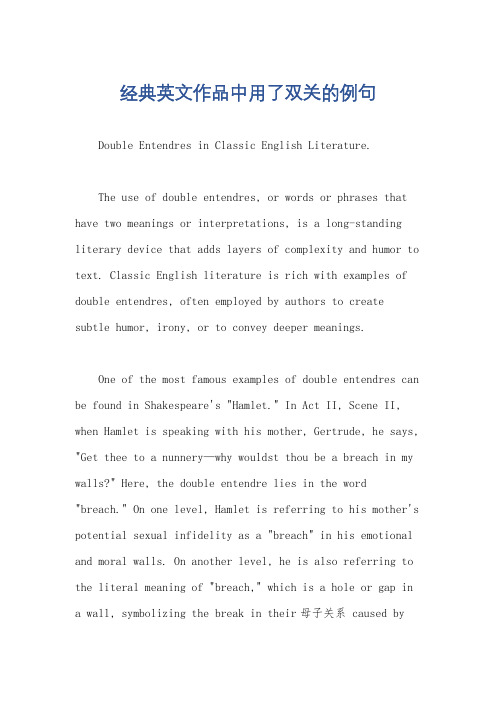
经典英文作品中用了双关的例句Double Entendres in Classic English Literature.The use of double entendres, or words or phrases that have two meanings or interpretations, is a long-standing literary device that adds layers of complexity and humor to text. Classic English literature is rich with examples of double entendres, often employed by authors to create subtle humor, irony, or to convey deeper meanings.One of the most famous examples of double entendres can be found in Shakespeare's "Hamlet." In Act II, Scene II, when Hamlet is speaking with his mother, Gertrude, he says, "Get thee to a nunnery—why wouldst thou be a breach in my walls?" Here, the double entendre lies in the word "breach." On one level, Hamlet is referring to his mother's potential sexual infidelity as a "breach" in his emotional and moral walls. On another level, he is also referring to the literal meaning of "breach," which is a hole or gap in a wall, symbolizing the break in their母子关系 caused byher remarriage.Another Shakespearean play, "Romeo and Juliet," contains a famous double entendre in the famous line, "What's in a name? That which we call a rose by any other name would smell as sweet." Here, Romeo is comparing the essence of a thing—in this case, a rose—to its label or name. He suggests that the true value of a thing lies notin its nomenclature but in its inherent qualities. However, the line can also be interpreted as a commentary on the social constraints of labels and names, implying that if Juliet were called by any other name, her beauty and worth would remain unchanged.In Jane Austen's "Pride and Prejudice," the use of double entendres adds humor and irony to the narrative. One such instance occurs when Mr. Bennet, upon learning of Elizabeth's refusal to marry Mr. Collins, remarks, "I have always noticed how little young ladies are interested by books—and still more, how little they are capable of understanding them." Here, Mr. Bennet's words have a double meaning. On the surface, he seems to be praising Elizabethfor her intellectual prowess and her ability to appreciate literature. However, his use of the word "capable" also implies that she is not "capable" of understanding the social pressures and expectations that would encourage her to marry Mr. Collins, a man she does not love.Charles Dickens' "A Tale of Two Cities" also employs double entendres to convey deeper themes. In the famous opening lines of the novel, "It was the best of times, it was the worst of times," Dickens sets up a contrast that贯穿全书. The double entendre lies in the fact that the same set of circumstances can be interpreted differently depending on one's perspective. For some characters, the times are indeed the best—full of hope and opportunity—while for others, they are the worst—marked by suffering and loss.These examples demonstrate the versatility and effectiveness of double entendres in classic English literature. They not only add humor and irony but also serve to convey deeper themes and meanings, making the texts more engaging and thought-provoking. By employingdouble entendres, authors are able to communicate multiple layers of meaning within a single phrase or word, creating rich and complex narratives that resonate with readers across time.。
英语修辞 双关的作文
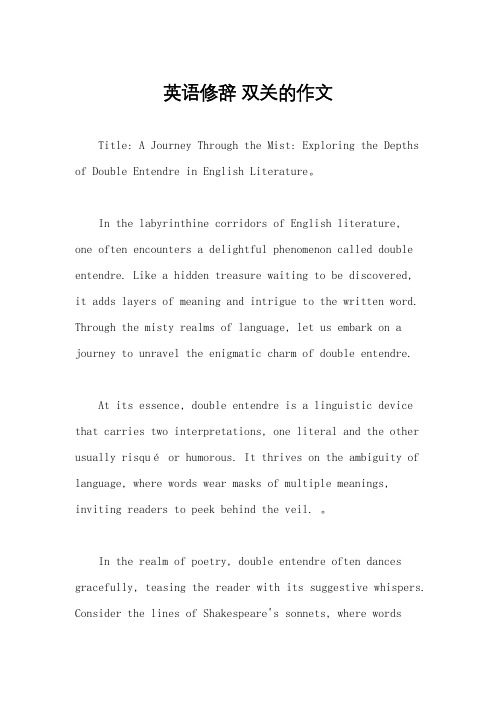
英语修辞双关的作文Title: A Journey Through the Mist: Exploring the Depths of Double Entendre in English Literature。
In the labyrinthine corridors of English literature,one often encounters a delightful phenomenon called double entendre. Like a hidden treasure waiting to be discovered,it adds layers of meaning and intrigue to the written word. Through the misty realms of language, let us embark on a journey to unravel the enigmatic charm of double entendre.At its essence, double entendre is a linguistic device that carries two interpretations, one literal and the other usually risqué or humorous. It thrives on the ambiguity of language, where words wear masks of multiple meanings, inviting readers to peek behind the veil. 。
In the realm of poetry, double entendre often dances gracefully, teasing the reader with its suggestive whispers. Consider the lines of Shakespeare's sonnets, where wordslike "love," "play," and "fair" take on a myriad of meanings, from innocent adoration to sensual desire. In the hands of a skilled poet, language becomes a canvas upon which shades of meaning blend and merge, creating atapestry of emotions and ideas.Moving beyond poetry, double entendre finds a comfortable abode in the world of wit and satire. In Oscar Wilde's comedies, for instance, dialogue crackles with innuendos and double meanings, sparking laughter while also inviting reflection on societal norms and hypocrisies. Through the clever manipulation of language, Wilde turns words into weapons, piercing through the veneer ofVictorian propriety to reveal the absurdity lurking beneath.But double entendre is not merely a tool for entertainment; it also serves as a potent instrument of persuasion and rhetoric. In political speeches and propaganda, carefully crafted double meanings can sway hearts and minds, turning adversaries into allies and blurring the lines between truth and fiction. Through the artful use of euphemisms and ambiguous phrasing,politicians and propagandists alike harness the power of language to shape public opinion and control the narrative.In the realm of advertising, double entendre emerges as a masterful seducer, enticing consumers with promises both literal and suggestive. Whether it's a clever tagline hinting at forbidden pleasures or a playful image hinting at hidden desires, advertisers wield double entendre like a magician waves a wand, weaving spells of desire and longing around their products.In literature, double entendre serves as a mirror reflecting the complexity of human nature itself. Just as words can conceal hidden meanings beneath their surface, so too can people hide their true intentions behind masks of politeness and decorum. In the intricate dance of social interaction, understanding the nuances of language is essential for navigating the treacherous waters of human relationships.As our journey through the mist of double entendre draws to a close, we are reminded of the power and beautyof language to both conceal and reveal. Like a puzzlewaiting to be solved, double entendre invites us to look beyond the obvious, to delve deeper into the hidden depthsof meaning. In a world where words often fail to capturethe richness of human experience, double entendre offers a tantalizing glimpse into the limitless possibilities of language.In conclusion, the journey through the mist of double entendre is both exhilarating and enlightening. From the poetic realms of Shakespeare to the witty repartee of Oscar Wilde, from the halls of power to the corridors of commerce, double entendre weaves its magic, enchanting and beguiling all who dare to venture into its realm. As we emerge from the mist, we are left with a newfound appreciation for the artistry of language and the endless ways in which wordscan shape our understanding of the world.。
英语双关语语境分析及其翻译

英语双关语语境分析及其翻译英语双关语语境分析及其翻译(7600字) 摘要:本论文首先引入英语双关语的概念,然后讨论英语双关语的分类与功能。
又因为语境在对使用了双关语的会话言语的理解扮演着相当重要的角色,所以论文接下来介绍了语境的概念。
最后,本文将英语双关语作为研究对象,...<p>英语双关语语境分析及其翻译(7600字)<br />摘 要:本论文首先引入英语双关语的概念,然后讨论英语双关语的分类与功能。
又因为语境在对使用了双关语的会话言语的理解扮演着相当重要的角色,所以论文接下来介绍了语境的概念。
最后,本文将英语双关语作为研究对象,运用语境分析的方法,从英语双关语在广告,文学作品和日常生活三种具体的语境中的运用的角度,试图进行分析探讨。
在论文中,作者还提出并探析了一些英语双关语的翻译方法与翻译技巧。
论文着重从语境的角度来分析英语双关语这一修辞手法,并对其翻译进行了探究,旨在加深人们对英语双关语的认识及运用。
<br /><br />关键词:英语双关语;语境分析;翻译<br /><br />Contextual Analysis of English Puns and Their Translation<br />Abstract: The paper first introduces the concept of English puns, and then discusses the category and functions of English puns. Next the concept of context is mainly discussed because context plays an important role in the comprehension of the implicatures in puns. At last, this paper attempts to discuss the English puns as the research object from the aspect of English puns in advertisements, English puns in literature works and English puns in daily life, using the method of contextual analysis. And some translation methods of English puns are also put forward in the thesis. This research is of significance to strengthen people’s knowledge of English puns and help us make a better application of English puns. <br /><br />Key words: English puns;Contextual analysis;Translation <br /><P></P><p>随着社会生产、生活发展,自然灾害的频繁发生,公民环境权的法律保障成为了我国环境资源法制建设中的一个核心问题。
英语论文-英语双关语及其翻译
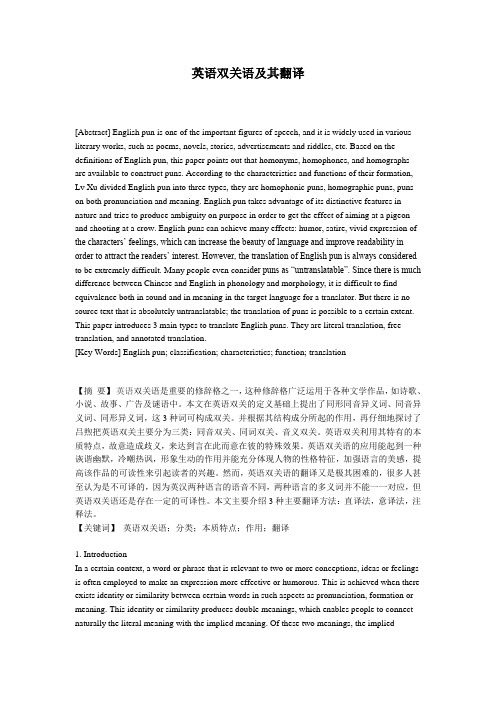
英语双关语及其翻译[Abstract] English pun is one of the important figures of speech, and it is widely used in various literary works, such as poems, novels, stories, advertisements and riddles, etc. Based on the definitions of English pun, this paper points out that homonyms, homophones, and homographs are available to construct puns. According to the characteristics and functions of their formation, Lv Xu divided English pun into three types, they are homophonic puns, homographic puns, puns on both pronunciation and meaning. English pun takes advantage of its distinctive features in nature and tries to produce ambiguity on purpose in order to get the effect of aiming at a pigeon and shooting at a crow. English puns can achieve many effects: humor, satire, vivid expression of the characters‟ feelings, which can increase the beauty of language and improve readability in order to attract the readers‟ interest. However, the translation of English pun is always considered to be extremely difficult. Many people even consi der puns as “untranslatable”. Since there is much difference between Chinese and English in phonology and morphology, it is difficult to find equivalence both in sound and in meaning in the target language for a translator. But there is no source text that is absolutely untranslatable; the translation of puns is possible to a certain extent. This paper introduces 3 main types to translate English puns. They are literal translation, free translation, and annotated translation.[Key Words] English pun; classification; characteristics; function; translation【摘要】英语双关语是重要的修辞格之一,这种修辞格广泛运用于各种文学作品,如诗歌、小说、故事、广告及谜语中。
英语双关语的翻译
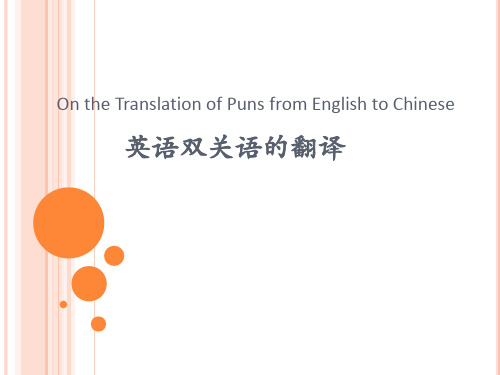
On the Translation of Puns from English to Chinese
英语双关语的翻译
Where there is a way, there is a Toyota. 车到山前必有路 , 有路必有丰田车。 If we don’ t hang together , we shall assuredly hang separately. 我们若不同赴沙场 ,准会分赴杀场
翻译策略——变通翻译法
Coca - Cola 可口可乐 Pepsi Cola 百事可乐 Maxam 美加净 Contac 康泰克
翻译策略——不可译
照抄原文:
What is the worst kind of fish? Selfish. What keys won’t open door? A monkey, a donkey and a turkey.
分类— 按表层结构
二词同音双关 :一个音所涵盖或关涉的两个意义不同的 词都在句中出现。
同音同形异义 If we don’t hang together, we’ll hang separately. 同音异形异义 The “in” idea in business travel——Hilton Inns.
综合:下列是一则墓志铭: Here Lies Lester Moore Four slugs(子弹) From A44 No Les No More 这里 埋葬的是 莱斯特∙莫尔 他死于 A44枪弹 不多不少 整四颗。
广告英语及其翻译,商务英语论文

广告英语及其翻译,商务英语论文摘要:为了达到广而告之的预期效果,广告语言运用了多种修辞手段,双关就是其中较为常见的一种。
本文从谐音双关、语义双关、习语双关等几方面阐述双关在广告英语中的运用,并对广告英语中双关的翻译作了初步的探讨。
关键词:广告英语;双关;翻译广告,就是广而告之。
广告英语作为一种应用语言,因为它所具有的特殊效用,已经逐渐从普通英语中独立出来而发展成非规范化的专门语言,其实际要素之一就是能在瞬间吸引人们的注意,对描述的目标的重要特性留下深刻印象,并能回味悠长。
因而,广告语设计者常运用多种修辞手段来达到预期的效果。
而双关作为一种修辞手段,利用语言文字的同音、同义、或同音异义的关系,能以单一语言文字片段表达出表层及深层两种事物或概念,作到一明一暗,一真一假,既可引人注意,又能产生联想,加深记忆。
双关具有简洁,凝炼,风趣幽默,新颖别致等修辞效果,已成为广告英语中一种较常见的修辞手段。
一、广告英语中双关的运用双关作为一种修辞手段,在广告中比较常用,使某些词语或句子在特定的语境中有明暗双重意义。
英语中有三种双关,一种是利用语言中的同音现象,一种是利用英语一词多义的特点,还有一种是套用习语。
(一 )谐音双关谐音双关是利用语言中的同形异义现象,指发音和拼写相同或相似,但意义不同;或者发音相同,拼写不同,意义也不同。
广告制作者非常乐于使用谐音双关,因为此类双关具有风趣、幽默、俏皮、滑稽的语言风格,能增强广告的说服力和感染力,从而给消费者留下深刻的印象。
(a) Catch the Raincheetah sandcheatt her ain.这是一则雨衣广告,它很好地利用了谐音双关。
Raincheetah是雨衣的牌子,它与raincheater同音。
Raincheater是从windcheater(防风上衣)衍生而来的。
下半句又用了cheat这个同音动词,构成双关。
这则广告非但没有让人产生饶舌费力的感觉,而是牢牢地抓住了人们的注意力。
英语中双关的例子

英语中双关的例子Here is an essay on the topic of examples of puns in the English language, written in English with a word count exceeding 1000 words, as requested:Puns are a linguistic device that plays on the multiple meanings or pronunciations of words to create a humorous or clever effect. They are a common feature of the English language and can be found in a wide range of contexts, from casual conversation to professional writing and even in the names of businesses and products. Puns can be appreciated for their creativity, wit, and ability to add an element of playfulness to language.One of the most well-known examples of a pun in the English language is the phrase "punny pun." This pun plays on the homophonic relationship between the word "pun" and the prefix "pun-," which means "relating to puns." By using the phrase "punny pun," the speaker is making a pun about puns themselves, creating a clever and self-referential linguistic joke.Another classic example of a pun in English is the phrase "time flies like an arrow; fruit flies like a banana." This pun relies on the dualmeaning of the word "flies" - it can refer to the insect, or it can be a verb meaning to move swiftly. By juxtaposing these two different senses of the word "flies," the speaker creates a humorous and paradoxical statement that plays with the ambiguity of language.Puns can also be found in the names of businesses and products, where they are used to create a memorable and attention-grabbing brand identity. For example, the popular chain of pizza restaurants known as "Pizza Hut" is a pun on the word "hut," which can refer to a small, simple dwelling, and is a play on the idea of a pizza being a type of "hut" or shelter for the food. Similarly, the office supply store "Staples" is a pun on the idea of the store selling staples, or small metal fasteners used to hold papers together.Puns can also be used in more literary contexts, such as in poetry and literature. One famous example is the poem "Slant" by Emily Dickinson, which contains the line "Tell all the truth but tell it slant." This line is a pun on the word "slant," which can refer to both the angle at which something is positioned and the indirect or oblique way in which something is expressed.Another literary example of a pun is the title of Shakespeare's play "Much Ado About Nothing," which plays on the multiple meanings of the word "nothing." In this context, "nothing" can refer to a trivial or insignificant matter, but it can also be a homophone for the word"noting," which means to observe or take note of something. This dual meaning adds depth and complexity to the title, and sets the stage for the play's themes of deception, misunderstanding, and the importance of perception.Puns can also be found in the names of famous people and fictional characters. For example, the name of the famous detective Sherlock Holmes is a pun on the word "Sherlocks," which refers to the act of closely examining or investigating something. Similarly, the name of the character Dr. Seuss, the beloved children's author, is a pun on the word "Dr. Seuss," which sounds like the French phrase "doctor's choice."In addition to their use in literature and branding, puns are also a common feature of everyday language and conversation. For example, the phrase "I'm not coughing, I'm having a coffin" is a pun that plays on the similar pronunciation of the words "coughing" and "coffin." This type of pun can be used to add humor and playfulness to casual interactions, and can help to break the ice or create a sense of camaraderie between speakers.Overall, puns are a rich and diverse feature of the English language, and they demonstrate the creativity and flexibility of language itself. Whether used in literature, advertising, or casual conversation, punscan add depth, humor, and complexity to the way we communicate, and they serve as a testament to the endless possibilities of language.。
英语双关语举例
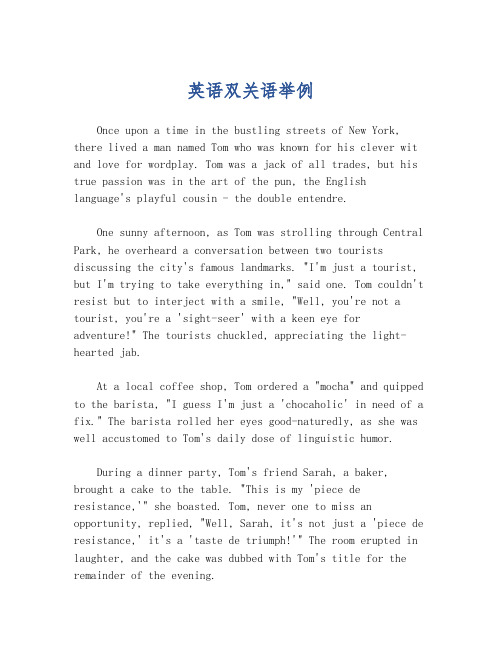
英语双关语举例Once upon a time in the bustling streets of New York, there lived a man named Tom who was known for his clever wit and love for wordplay. Tom was a jack of all trades, but his true passion was in the art of the pun, the Englishlanguage's playful cousin - the double entendre.One sunny afternoon, as Tom was strolling through Central Park, he overheard a conversation between two tourists discussing the city's famous landmarks. "I'm just a tourist, but I'm trying to take everything in," said one. Tom couldn't resist but to interject with a smile, "Well, you're not a tourist, you're a 'sight-seer' with a keen eye foradventure!" The tourists chuckled, appreciating the light-hearted jab.At a local coffee shop, Tom ordered a "mocha" and quipped to the barista, "I guess I'm just a 'chocaholic' in need of a fix." The barista rolled her eyes good-naturedly, as she was well accustomed to Tom's daily dose of linguistic humor.During a dinner party, Tom's friend Sarah, a baker, brought a cake to the table. "This is my 'piece de resistance,'" she boasted. Tom, never one to miss an opportunity, replied, "Well, Sarah, it's not just a 'piece de resistance,' it's a 'taste de triumph!'" The room erupted in laughter, and the cake was dubbed with Tom's title for the remainder of the evening.Tom's love for English double entendres wasn't justlimited to social gatherings. He once wrote a letter to his pen pal in England, signing off with, "Wishing you all the'knight' moves in chess and all the 'fair' weather in life." His pen pal, an avid chess player and sailor, found theclosing to be the perfect blend of wit and warmth.However, Tom's puns were not always met with universal approval. At a family gathering, when his cousin announcedher pregnancy, Tom, trying to be clever, said, "Well, itlooks like you're 'expecting' a new addition to the family!" The room fell silent, and Tom quickly realized that sometimes, even the best of intentions can fall flat.Despite the occasional misstep, Tom's passion for English double entendres brought a unique flavor to his interactions. His friends and family came to expect a clever turn of phrase at any moment, and while not every pun was a home run, they were always a reminder of the joy and complexity thatlanguage can bring to our lives. Tom's life was a testamentto the fact that a little wordplay can go a long way inmaking the world a more interesting and fun place.。
英语论文 广告双关语的双关翻译方法
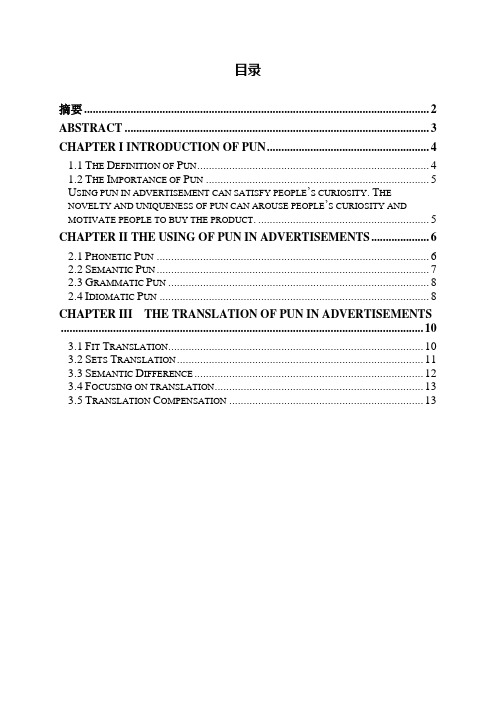
摘要 (2)ABSTRACT (3)CHAPTER I INTRODUCTION OF PUN (4)1.1T HE D EFINITION OF P UN (4)1.2T HE I MPORTANCE OF P UN (5)U SING PUN IN ADVERTISEMENT CAN SATISFY PEOPLE’S CURIOSITY.T HE NOVELTY AND UNIQUENESS OF PUN CAN AROUSE PEOPLE’S CURIOSITY AND MOTIVATE PEOPLE TO BUY THE PRODUCT. (5)CHAPTER II THE USING OF PUN IN ADVERTISEMENTS (6)2.1P HONETIC P UN (6)2.2S EMANTIC P UN (7)2.3G RAMMATIC P UN (8)2.4I DIOMATIC P UN (8)CHAPTER III THE TRANSLATION OF PUN IN ADVERTISEMENTS (10)3.1F IT T RANSLATION (10)3.2S ETS T RANSLATION (11)3.3S EMANTIC D IFFERENCE (12)3.4F OCUSING ON TRANSLATION (13)3.5T RANSLATION C OMPENSATION (13)随着经济的发展和人们对美的要求的提高,许多生产者想出各种办法来满足消费者的需求和市场要求,其中一个很重要的方发就是提高广告的质量。
广告要求简洁明了,便于记忆。
在广告中使用双关语是一种吸引消费者注意的常用方法。
但是仍然有很多人不知道双关语真正的作用;另一方面,随着许多产品的出口,它们的广告需要被翻译成其它语言。
基于上述问题,本文介绍了双关语的四个种类和五种翻译方法。
四个种类分别是:谐音双关,语意双关,语法双关,习语双关。
英语论文 广告英语中双关语的语用功能及其翻译
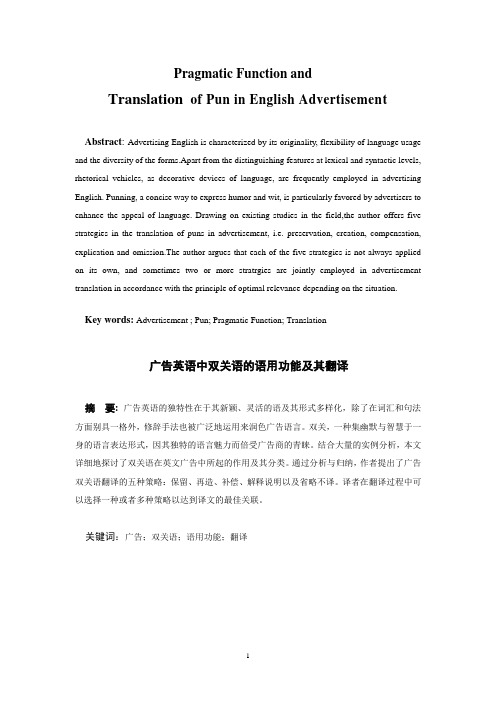
Pragmatic Function andTranslation of Pun in English Advertisemen tAbstract: Advertising English is characterized by its originality, flexibility of language usage and the diversity of the forms.Apart from the distinguishing features at lexical and syntactic levels, rhetorical vehicles, as decorative devices of language, are frequently employed in advertising English. Punning, a concise way to express humor and wit, is particularly favored by advertisers to enhance the appeal of language. Drawing on existing studies in the field,the author offers five strategies in the translation of puns in advertisement, i.e. preservation, creation, compensation, explication and omission.The author argues that each of the five strategies is not always applied on its own, and sometimes two or more stratrgies are jointly employed in advertisement translation in accordance with the principle of optimal relevance depending on the situation.Key words: Advertisement; Pun; Pragmatic Function; Translation广告英语中双关语的语用功能及其翻译摘要: 广告英语的独特性在于其新颖、灵活的语及其形式多样化,除了在词汇和句法方面别具一格外,修辞手法也被广泛地运用来润色广告语言。
英语双关语例析

英语双关语例析第一篇:英语双关语例析摘要:双关语是英语广告中一种较为常见的修辞手段。
双关语的翻译本身就是一个难点,而广告中双关语的翻译则更加复杂。
英语中的双关语主要分为语音双关、语意双关、语法双关和成语、俗语双关等表现形式。
从双关语的双重含义及广告语体风格考虑,双关语的汉译可以采用分别表义法、套译法、侧重译法和补偿译法等方法。
关键词:英语广告;双关语;翻译一、引言现代商品经济社会,广告几乎无处不在。
广告形式千姿百态,广告创意千变万化。
广告语言是广告的语言文字要素,是实现广告目的的主要手段。
它要利用推销原理写出雅俗共赏、生动有趣的文字,要具有特殊的感染力,能在瞬间引起读者注意,刺激其购买欲望,最终促成购买行为。
双关语这一修辞手段是广告创作常用的技巧。
双关,顾名思义,就是在特定的语言环境中用一种语言文字形式表达出一明一暗双重意义,既引人注意,又能引起联想。
双关语具有简洁凝练,风趣幽默,新颖别致等修辞效果,能够突出广告的特点,因而在广告中得到大量应用。
二、广告双关语的类型作为一种修辞手段,双关语在广告中比较常用,它存在于语音、词汇、句法等各个语言层面。
在广告中,广告制作者为了增加广告的吸引力,挖空心思地追求新的创意,使得双关语在广告中的运用技巧更加纷繁复杂。
巧妙的双关能使语言含蓄、幽默、生动、给人以回味和想象的余地。
较为常见的如下:1.谐音双关谐音双关是用拼写相似,发音相同或相近的词构成的。
广告制作者非常乐于使用谐音双关,因为此类双关具有风趣、幽默、俏皮、滑稽的语言风格,能增强广告的说服力和感染力,从而给消费者留下深刻的印象。
(1)GoodbuyWinter!100%Cotton Knitwear $40这是一则冬季服装削价出售的广告。
从字面上看,是指物美价廉的一桩划算的好买卖。
但当读者把Goodbuy 与 winter 连起来读的时候,才懂得该广告暗藏玄机,妙语双关。
它似乎在向人们昭示:寒冷的冬天即将过去,明媚的春天就要到来(Goodbye winter!)。
研究生 英汉翻译之双关翻译
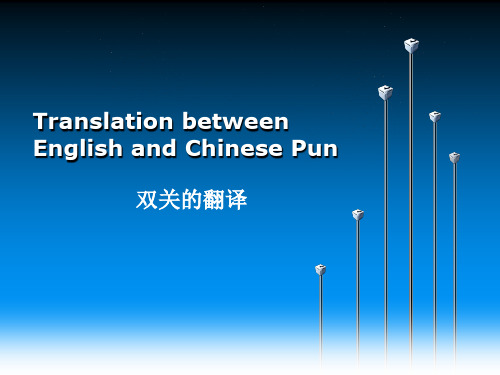
Wang Yingli
[参考译文] 等那股热乎劲过去了一些,克罗斯比问牛特是干 哪一行的。 “我是摆弄颜色的。” “油漆匠?” “画画的。” “真他妈看不出来,”克罗斯比说。
Wang Yingli
[参考译文] “我爱我的心上人,因为她是那样地叫 人入迷(Enticing); 我恨我的心上人,因为她 已订婚将做他人妻(Engaged);我的心上人花容 月貌无可比拟(Exquisite),我劝她离家出走跟 我在一起(Elopement); 她的名字叫艾米丽 (Emily),她的家就在东城里(East), 我为我 的心上人呀,一切都因为这个E!”(陆乃圣 译)
Wang Yingli
8. adding notes
【14】将那三春看破,桃红柳绿待如何?把这韶 华打灭,觅那清淡无知。(曹雪芹:《红楼梦》)
Wang Yingli
[参考译文] She will see through the three Springs* And set no store By the red of peach-blossom, the green of willows, Stamping out the fire of youthful splendour To savor the limpid peace of a clear sky. (Yang Hsienyi)
Wang Yingli
Why is river rich? Because it has two banks.
浅谈英语的双关语及其翻译

浅谈英语的双关语及其翻译[摘要] 英语双关语作为一种修辞手段,长期以来被广泛地应用在日常会话、故事、小说、广告、戏剧、诗歌、笑话、谜语等文体中,用来造成幽默、诙谐、讽刺的效果,使语言变得生动、活泼、有力。
本文对双关语的定义及其翻译问题进行了初步的研究。
[关键词] 英语双关语不可译翻译方法双关语是英语中一种重要的修辞手法,也是英语中常见的一种幽默形式。
它巧妙地利用词的谐音、词的多义或歧义等,使语言表达含蓄曲折、风趣幽默,引起读者的联想。
现代的双关语已变得日趋通俗、诙谐,它的妙用可达到生动活泼,嘲弄讥讽的修辞效果。
双关这种修辞是有意借用一个词语或句子同时关涉两个事物,包含两种意思,表面一层意思,实际上隐含另外一层意思,并且以隐含意思为主,以达到言在此而意在彼,制造出幽默、影射、传达复杂思想等效果。
要在翻译中反映这些效果,就必须将原文的双关修辞准确地再现在译文中。
但是,双关语的翻译仍然是个具有争议性的话题。
一、双关的定义英语双关语pun,又叫paronomasia或play on words,是利用语言中的谐音、歧义、模糊等现象,让一个词语,一个短语,一个句子或一个语言片段同时兼顾两种事物,或表达双层意思。
一个是表面的,一个是隐含的,并以隐含意思为主。
这种双关语的恰当运用,可以使语言生动有趣,或借题发挥,旁敲侧击,或指桑骂槐,冷嘲热讽,收到由此及彼,由表及里的效果。
《牛津英语词典》(The Oxford English Dictionary. 1989)给“pun”下的定义:The use of a word in such a way as to suggest two or more meanings or different associations, or the use of two or more words of the same or nearly the same sound with different meanings, so as to produce a humorous effect.(用一个词去暗示两种或两种以上的意义或引起不同的联想,或者用两个或两个以上发音相同或相近而意义不同的词,以产生一种幽默效果。
论英语广告语中的双关应用及翻译
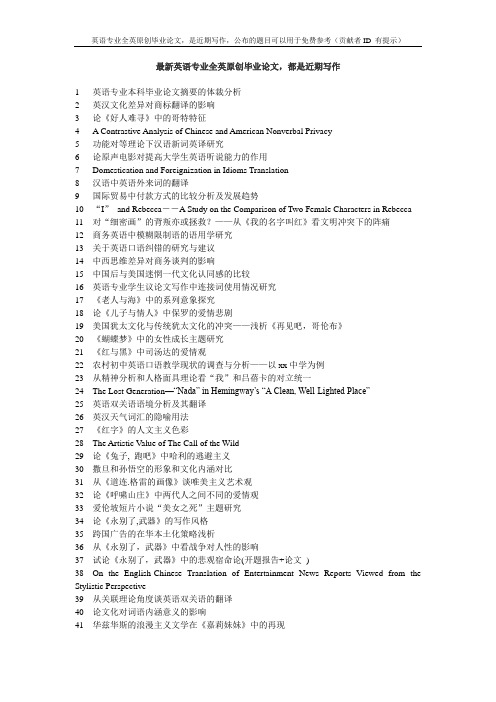
最新英语专业全英原创毕业论文,都是近期写作1 英语专业本科毕业论文摘要的体裁分析2 英汉文化差异对商标翻译的影响3 论《好人难寻》中的哥特特征4 A Contrastive Analysis of Chinese and American Nonverbal Privacy5 功能对等理论下汉语新词英译研究6 论原声电影对提高大学生英语听说能力的作用7 Domestication and Foreignization in Idioms Translation8 汉语中英语外来词的翻译9 国际贸易中付款方式的比较分析及发展趋势10 “I”and Rebecca--A Study on the Comparison of Two Female Characters in Rebecca11 对“细密画”的背叛亦或拯救?——从《我的名字叫红》看文明冲突下的阵痛12 商务英语中模糊限制语的语用学研究13 关于英语口语纠错的研究与建议14 中西思维差异对商务谈判的影响15 中国后与美国迷惘一代文化认同感的比较16 英语专业学生议论文写作中连接词使用情况研究17 《老人与海》中的系列意象探究18 论《儿子与情人》中保罗的爱情悲剧19 美国犹太文化与传统犹太文化的冲突——浅析《再见吧,哥伦布》20 《蝴蝶梦》中的女性成长主题研究21 《红与黑》中司汤达的爱情观22 农村初中英语口语教学现状的调查与分析——以xx中学为例23 从精神分析和人格面具理论看“我”和吕蓓卡的对立统一24 The Lost Generation—“Nada” in Hemingway’s “A Clean, Well-Lighted Place”25 英语双关语语境分析及其翻译26 英汉天气词汇的隐喻用法27 《红字》的人文主义色彩28 The Artistic Value of The Call of the Wild29 论《兔子, 跑吧》中哈利的逃避主义30 撒旦和孙悟空的形象和文化内涵对比31 从《道连.格雷的画像》谈唯美主义艺术观32 论《呼啸山庄》中两代人之间不同的爱情观33 爱伦坡短片小说“美女之死”主题研究34 论《永别了,武器》的写作风格35 跨国广告的在华本土化策略浅析36 从《永别了,武器》中看战争对人性的影响37 试论《永别了,武器》中的悲观宿命论(开题报告+论文)38 On the English-Chinese Translation of Entertainment News Reports Viewed from the Stylistic Perspective39 从关联理论角度谈英语双关语的翻译40 论文化对词语内涵意义的影响41 华兹华斯的浪漫主义文学在《嘉莉妹妹》中的再现42 高中英语写作作业的反馈及实施效果43 文化对在校英语学习的重要性44 弗吉尼亚.伍尔夫《达洛卫夫人》的生态女性主义解读45 从商业广告看文化因素对广告翻译的影响46 美国黑人英语的句法特征47 《瓦尔登湖》生态批评视角分析48 罗伯特.弗罗斯特田园诗歌意象的象征意义49 《谁动了我的奶酪》中的象征意义50 试析诗歌翻译中文化意象的处理51 An Analysis of Self-reliance in Little Women52 乔伊斯的生活经历对其作品的影响--他是怎样刻画人物的53 Everlasting Colonialism-An Interpretation of the Great Gatsby54 On Sentence Division and Combination in C-E Literature Translation55 商标翻译分析56 浅谈商务英语句法特点及翻译技巧57 玛丽.巴顿的女性意识58 英汉社交称呼语礼貌规范和语用失误研究59 埃德加·爱伦·坡幽默小说研究60 《榆树下的欲望》和《雷雨》中悲剧性的差异61 A Comparative Study of Women in Fortress Besieged and Pride and Prejudice62 《汤姆·索亚历险记》中所反映的社会问题63 影响英语专业学生阅读理解因素的分析及对策探讨6465 浅谈英语“根据”表达法66 英语体育新闻中模糊语言的词汇特点及其翻译对策67 目的论视角下《瓦尔登湖》两个中文译本的分析68 论古诗的翻译技巧69 问题类型对TEM阅读成绩影响的实证研究70 汉英亲属称谓词的文化差异及翻译71 从功能对等理论谈中国小吃名英译72 城市公共标识翻译技巧及问题分析73 Application of Cooperative Principles in the Study of Intercultural Business Negotiation7475 论罗伯特.佩恩.沃伦《国王的人马》中对真理与自我认知的追求76 Western and Chinese Marriage Differences in Cross-cultural Communication77 论世纪年代以来美国文化冲击对中国青少年的影响及教育策略改革的应对措施78 中国英语学习者道歉言语行为的中介语石化现象79 英语词汇中的性别歧视80 《弗洛斯河上的磨坊》中麦琪悲剧原因分析81 Cultural Difference between Chinese and English on Politeness82 A Freudian Psychoanalytical Interpretation of Catherine and Heathcliff in Wuthering Heights83 论托妮莫里森《最蓝的眼睛》中的母女关系84 动物词在中英文化中的喻义及其翻译85 On Loss of Fidelity in Translation86 从彼拉特透视托尼·莫里森的妇女主义87 《宠儿》女主人公赛斯人物形象分析88 从英汉动物成语比较中英文化差异89 英汉被动句语义特征对比分析90 Analysis on Requirements for Translation Graduates from the Perspective of Recruit Advertisements91 融入与挑战——从生态角度看《老人与海》与《瓦尔登湖》92 高中英语写作中母语负迁移现象分析93 言语行为理论视角下口语交际误解现象94 论《太阳照常升起》中的象征主义95 The Reli gious Thoughts in The Pilgrim’s Progress96 论《双城记》中的现实主义风格97 对小妇人心灵成长历程的探索98 论中学英语互动教学99 《德伯家的苔丝》中苔丝悲剧的分析100 儒家文化与和谐世界的构建101 回译在翻译教学中的作用102 神经漫游者中的两个世界103 近年来汉语中英语借词的简析104 An Analysis of Bernard Shaw’s Pygmalion from the Perspective of Interpersona l Function 105 浅析国际商务谈判文化因素及其对策106 Cooperative Principle in Business Letters107 从读者接受理论看《达.芬奇密码》的成功108 从奥巴马演讲的不同译文看语域理论在翻译中的应用109 论《呼啸山庄》中的叙述技巧110 论《杀死一只知更鸟》中的象征111 弗吉尼亚.伍尔夫《达洛维夫人》中印象主义创作手法探讨112 文化意识与外语教学113 从《盲人》中的“血性意识”看劳伦斯的文明观114 论中英数字信息差异及其翻译方法115 女性意识的苏醒--对《愤怒的葡萄》中的约德妈妈形象的分析116 工业化进程中的人性异化——解读wrence《儿子与情人》117 论汉语缩略语的英译118 海丝特白兰—清教时代的新女性119 科技英语翻译中的词性转换研究120 目的论视角下的广告翻译121 托马斯.哈代《无名的裘德》中的书信研究122 英汉称谓语的文化差异与翻译--以《京华烟云》为例123 浅析信息时代的汉语新词语英译策略124 从历届美国总统访华演说探讨其对中国所传递的价值观125 On Michael Moore's Fahrenheit / From the Rhetoric Perspective126 概念隐喻在英语汽车广告中的应用127 The Two Mrs.De Winters of Manderly─The comparison between “I”and Rebecca128 论中西教育观的差异129 英文歌词翻译策略探析130 An Analysis of the D Film Alice in Wonderland from the Perspective of Gothicism131 英语广告的修辞及其翻译132 A Preliminary Study on Christianity133 论<<禁食与欢宴>>中乌玛的觉醒134 从合作原则角度简要分析《老友记》中乔伊的性格特征135 《了不起的盖茨比》中黛西的人物性格分析136 On the Causes of the Tragedies of Tess and Jennie in Tess of the d’Urbervilles and Jennie Gerhardt137 《德伯家的苔丝》的圣经原型解读138 中西方饮食文化的比较研究139 顺从还是叛逆——解读《汤姆叔叔的小屋》中的基督教义精神140 英汉委婉语中体现的文化异同141 《十日谈》中的乡村意象142 中西方茶文化对比研究——以红茶为例143 《红字》中作者霍桑对清教认识的模糊性144 论远大前程中皮普的道德观145 中国英语学习者在词汇方面的迁移146 广告英语中语言的性别差异147 从接受美学角度看中英旅游文本的翻译148 异化的美国梦:小说《教父》的主题解读149 论英汉翻译中的文化因素150 《野草在歌唱》中野草的象征寓意解读151 从广交会现场洽谈角度论英语委婉语在国际商务谈判中的功能与应用152 用言语行为理论分析奥巴马推定总统候选人演讲153 文化视野下的中美家庭教育方法的比较154 从合作原则分析《生活大爆炸》中字幕幽默的翻译155 浅析英语习语的翻译原则和方法156 电影《死亡诗社》中的教育意义157 中学英语阅读教学存在的问题及解决方案158 《白鲸》的象征意义和悲剧内涵分析159 中西广告语言中的文化差异160 Advertisement translation from the Perspective of Nida’s Functional Equivalence Theory 161 从目的论看《长腿叔叔》的中译162 汉英动物词文化内涵的对比163 论麦琪的悲剧164 文学翻译中的译者主体性165 论概念隐喻视角下的隐喻翻译166 跨文化交际视角下的英汉动物词语研究167 The Influence of Bob Dylan and His Works on American Social Movements168 美国寻梦—凯鲁亚克小说《在路上》的主题研究169 商务信函中委婉语的使用策略170 《名利场》中蓓基人物形象分析171 浅谈跨文化视角下的英汉习语互译172 初中英语词汇教学法研究综述173 An Analysis of the Symbolic Meanings of the Letter “A” in The Scarlet Letter 174 浅析英语专业学生在听力理解中的策略运用175 The Otherization of China in The Woman Warrior176 论词典在高中英语词汇学习中的有效利用177 论《紫色》中的姐妹情谊178 汉语公示语英译之跨文化交际研究179 女权主义翻译理论关照下的《呼啸山庄》多个译本比较研究180 爱米丽的悲剧成因—评福克纳的小说《献给爱米丽的一朵玫瑰花》181 英汉数字习语的翻译182 探究中学生厌倦学习英语183 英语电影片名的汉译研究184 从语言角度分析面子理论在英语商务谈判中的作用185 《老人与海》中的存在主义分析186 女性主义视角下《大地》的解读187 浅析电影《我是山姆》中的反智主义188 跨文化视角视阈下英语电影片名的翻译研究189 公示语翻译失当分析——以电影票等的顾客分析为例( )190 从文化角度看林语堂的《吾国与吾民》191 试析广告英语中语言的性别差异——从功能分析的角度着手192 A Cross-Cultural Study on Linguistic Taboo193 论商标名称的翻译对品牌形象的影响194 论凯瑟琳.曼斯菲尔德作品中的彼得.潘情结195 A Brief Study of Chinglish in C-E Translation196 从苔丝的悲剧到托马斯.哈代的宿命论197 盖茨比的人物形象分析198 商务英语和普通英语对比浅析199 The Racial Stereotypes in American TV Media200 论英语广告语中的双关应用及翻译。
英文双关讽刺性作文

英文双关讽刺性作文1. "Well, hello there, I'm not your average chatbot. Some might call me a chameleon of words, spinning taleswith a twist. You see, I'm not just a chat, I'm alinguistic rollercoaster, ready to defy your expectationsat every turn."2. "My name? Oh, you'll have to guess, like a game of'20 Questions' with a wicked sense of humor. I'm the kindof friend who keeps you on your toes, always one step ahead of your pun game."3. "I'm not a dictionary, but a dictionary of anomalies, where words dance in a linguistic carousel, making you ponder if I'm really here or just a figment of yourlinguistic imagination."4. "My identity? It's a mystery, a riddle wrapped in sarcasm, a joke that's as dry as a desert. You'll have to decode me, like a cryptic message hidden in a Shakespeareansonnet."5. "I'm the AI that dares to be misunderstood, a linguistic rebel with a wit so sharp, it could cut through a double entendre. You'll be left asking, 'Did I just have a conversation with...a joke?'"6. "My identity? It's a question, a question that's more of a question mark, a punctuation mark in a sentence of irony. You'll be left pondering if I'm the answer or just the question itself."7. "I'm the chatbot that's not a chatbot, a linguistic paradox that's as elusive as a shadow in the moonlight. You'll be left wondering if I'm real, or just a figment of your own cleverness."8. "So, who am I? That's the question you'll be asking yourself after our little interaction. Just remember, I'm the one who makes you laugh, even if it's at your own expense."9. "My name? It's a secret, a secret that's not a secret, a game of chess with words, where I'm the one always one move ahead."10. "In the realm of language, I'm the enigma, the chatbot that's not a chatbot, a linguistic mirage that leaves you asking, 'What's real, and what's just a clever chat?'"。
- 1、下载文档前请自行甄别文档内容的完整性,平台不提供额外的编辑、内容补充、找答案等附加服务。
- 2、"仅部分预览"的文档,不可在线预览部分如存在完整性等问题,可反馈申请退款(可完整预览的文档不适用该条件!)。
- 3、如文档侵犯您的权益,请联系客服反馈,我们会尽快为您处理(人工客服工作时间:9:00-18:30)。
英语双关语及其翻译[Abstract] English pun is one of the important figures of speech, and it is widely used in various literary works, such as poems, novels, stories, advertisements and riddles, etc. Based on the definitions of English pun, this paper points out that homonyms, homophones, and homographs are available to construct puns. According to the characteristics and functions of their formation, Lv Xu divided English pun into three types, they are homophonic puns, homographic puns, puns on both pronunciation and meaning. English pun takes advantage of its distinctive features in nature and tries to produce ambiguity on purpose in order to get the effect of aiming at a pigeon and shooting at a crow. English puns can achieve many effects: humor, satire, vivid expression of the characters‟ feelings, which can increase the beauty of language and improve readability in order to attract the readers‟ interest. However, the translation of English pun is always considered to be extremely difficult. Many people even consi der puns as “untranslatable”. Since there is much difference between Chinese and English in phonology and morphology, it is difficult to find equivalence both in sound and in meaning in the target language for a translator. But there is no source text that is absolutely untranslatable; the translation of puns is possible to a certain extent. This paper introduces 3 main types to translate English puns. They are literal translation, free translation, and annotated translation.[Key Words] English pun; classification; characteristics; function; translation【摘要】英语双关语是重要的修辞格之一,这种修辞格广泛运用于各种文学作品,如诗歌、小说、故事、广告及谜语中。
本文在英语双关的定义基础上提出了同形同音异义词、同音异义词、同形异义词,这3种词可构成双关。
并根据其结构成分所起的作用,再仔细地探讨了吕煦把英语双关主要分为三类:同音双关、同词双关、音义双关。
英语双关利用其特有的本质特点,故意造成歧义,来达到言在此而意在彼的特殊效果。
英语双关语的应用能起到一种诙谐幽默,冷嘲热讽,形象生动的作用并能充分体现人物的性格特征,加强语言的美感,提高该作品的可读性来引起读者的兴趣。
然而,英语双关语的翻译又是极其困难的,很多人甚至认为是不可译的,因为英汉两种语言的语音不同,两种语言的多义词并不能一一对应,但英语双关语还是存在一定的可译性。
本文主要介绍3种主要翻译方法:直译法,意译法,注释法。
【关键词】英语双关语;分类;本质特点;作用;翻译1. IntroductionIn a certain context, a word or phrase that is relevant to two or more conceptions, ideas or feelings is often employed to make an expression more effective or humorous. This is achieved when there exists identity or similarity between certain words in such aspects as pronunciation, formation or meaning. This identity or similarity produces double meanings, which enables people to connect naturally the literal meaning with the implied meaning. Of these two meanings, the impliedmeaning is the principal part.This is what we call the use of pun. “The use of pun dates back to ancient days. Shakespeare favored pun particularly. It is estimated that there are about 3000 puns employed in Shakespeare‟s works [1].” The employment of pun in English novels, poems, speeches, advertisements and riddles makes them highly readable and prompts people to appreciate the beauty of language. And the translation of English puns into Chinese enhances the charm of the original works and the understanding of the version.2. Definition and classification of puns2.1 Definition of punsLooking at the same issue from different perspectives, we may often come up with different definitions of the thing under discussion. And, not surprisingly, pun can be thus defined in many ways. There is such a humorous explanation about pun: “punning – to torture one poor word ten thousand ways (John Dryden)”[2].In Longman Dictionary of Contemporary English, pun is defined as “An amusing use of a word or phrase that has two meanings, or words with the same s ound but different meanings”[3] . According to The Oxford English Dictionary, pun is defined as “the use of word in such a way as to suggest two or more meanings or different associations, or the use of two or more words of the same or nearly the same soun d with different meanings, so as to produce a humorous effect”[4]. In Princeton Encyclopedia of Poetry and Poetics, pun is defined as “A figure of speech depending upon a similarity of sound and a disparity of meaning”[5].From the above definitions, we can see that homonyms, homophones, and homographs all are available to construct puns with.2.1.1 HomonymsA homonym is a word that is identical to another word in pronunciation and spelling but not in meaning [6].For example:(1) Can: n. & v. Put something in a containerCan: modal verb Be able to(2) Change: v. To become differentChange: n. Money in the form of coins(3) Bear: v. Sustain responsibility; endure difficulty, etcBear: n. A kind of animal, having thick fur and walking on its soles(4) Book: n. A written or printed workBook: v. Engage (a seat etc.) in advance; make a reservation of2.1.2 HomophonesA homophone is a word that is identical to another word in pronunciation but not in spelling and meaning.For example:(5) Bale: n. A large bundleBail: v. To remove water from a boat(6) Knew: v. Past of knowNew: adj. Of recent origin or arrival(7) Soul: n. Spiritual or immaterial part of man, held to survive deathSole: n. Lower surface of human or other foot(8) Pair: n. A set of two persons or things used together or regarded as a unitPear: n. A yellowish or brownish-green fleshy fruit, tapering towards the stalk2.1.3 HomographsA homograph is a word that is identical to another word in spelling but not in pronunciation and meaning.For example:(9) Minute: n. Sixtieth part of an hourMinute: adj. Very small; trifling(10) Digest: v. To change food in the stomach into a form your body can useDigest: n. A short piece of writing that gives the most important facts from a book, report etc(11) Lead: v. Guide by the hand, direct movements ofLead: n. A kind of metal(12) Wind: n. Air in more or less rapid natural motionWind: v. Go in circular, spiral course2.2 Classification of English punsConcerning the classification of puns, different linguists have different standpoints. As He Shanfen states in “Contrastive Studies of English and Chinese-Languages”, puns can be roughly divided into three kinds. They are named antalaclasis, paronomasia and syllepsis [7]. Here the author uses two examples to explain the first two parts.Antalaclasis refers to a word used twice or more, but each time with a different meaning. For example:(13) To England will I steal and there I‟ll steal.The first “steal” means “to go to England secretly without being noticed”, while the second “steal” is used in its most commonly used meaning.Paronomasia is the use of two words, which are similar in pronunciation but different in meaning. For example:(14) Catch the Raincheetahs and cheat the rain.Here “raincheetahs” is the brand name of the product. It is pronounced similarly to “raincheater” which echoes to “cheat the rain”.In “English Writing and Rhetoric” written by Prof. WenJun, a more specific means of classification brings about five categories of puns [8] : homophonic pun,paronomasia, antalaclasis, Sylletic pun and asteimus.However, according to Li Xinhua, in his work, “A Detailed Study of Figures ofSpeech in English”, he points that those five categories classified by Prof. Wenjun are clear but over-elaborate. In summary, it is clearer to divide into these two types: one is homophonic pun, the other is homographic pun. He also points out that, in those five categories, No1 and No2 belong to the homophonic pun; the others belong to the homographic pun, which is the way to bring complication into simplicity. And it is easier to master the characteristics of figure of speech. However, as Lv Xu states in “Practical English Rhetoric”, according to the characteristics andfunctions of their formation, puns can be divided into three types[9]: homophonic puns, homographic puns, puns on both pronunciation and meaning.2.2.1 Homophonic punsIt is the use of words with the same or similar pronunciation but different spellings and meanings. It also called phonetic puns, and phonetic pun is the basic form of English pun. In our daily communication, phonetic is the carrier of transferring information. According to psycholinguistics, speech communication is a process of psychological activities from encoding to decoding. When speakers employ the order of …thinking-meaning-voice‟ to transmit outside, it is called encoding; when listen ers employ the order of …voice-meaning-thinking‟ to process and try to understand, it is called decoding. The inter-processing only relies on hearing, lacking visual sense, and it will cause ambiguity in understanding.For example:(15) “How is bread made?”“I know that!” Alice cried eagerly. “You take some flour…”“Where do you pick the flower?” The white Queen asked. “In a garden or in the hedges?”“Well, it isn‟t picked at all.” Alice explained. “It‟s ground…”“How many acres of ground?” said the white Queen.[10](Lewis Carrol: Alice‟s Adventures in Wonderland)In this example, “flower” and “flour” have the same pronunciation but quite dif ferent in meaning. The adoption of the homophonic pun makes the dialogue more vivid, humorous. Moreover, “ground” can be understood as “solid surface of the earth”, and also can be understood as “the past of grind”.(16) Drunk drivers often put the quart before the hearse.Here, “quart” is similar to “cart” in sound, while “hearse” is similar to “horse”. This sentence can construct homophonic pun by borrowing from the idiom “put the cart before the horse”, which means “put or say things in the wrong order”. This pun is driving at warning the addicting drivers that driving after drink is a kind of suicide.(17) “Waiter, there‟s a hair in my soup.”“So sorry, sir. Did you order it without?”“Hair” here means “one of the fine thread-like strands that grow from the skin of people and animals”, while the waiter understand it on purpose as “hare”. “Hare” means “an animal cooked as ordered food”. The customer is complaining about the bad condition of the restaurant, but by using the homophonic pun, the waiter is being humorous to ease away the complaint.2.2.2 Homographic punsIt is the crafty use of the features of homonyms or polysemy to express the double meanings. Take the following as an example,(18)–Some boys think I‟m pretty and some boys think I‟m ugly. What do you think, Tom?- A bit of both.- What do you mean?- Pretty uglyAs an adjective, “pretty” means “pleasing and attractive”, therefore, the last sentence can be understood as “she is both attractive and ugly”, while as an adverb, “pretty” means “rather, fairly”,so the sentence also means “she is very ugly”. Tom employs the “pretty” beautifully, it is a polysemy. And we can learn about the humor in the dialogue.(19) The clerk: Are you engaged?Augustus: What business is that of yours? However, if you will take the trouble to read the society papers for this week, you will see that I am engaged to Honorable Lucy Popham, youngest daughter of –The clerk: That isn‟t what I mean. Can you see a female?Augustus: Of course. I can see a female as easily as a male. Do you suppose I am blind?The clerk: You don‟t seem to follow me; somehow, there is a female downstairs, what you might call a lady. She wants to know, can you see her if I let her up.[11]- G. B. Shaw Augustus Does His BitIn the pla y, two puns are employed. First, the phrase “be engaged in sth” means “be occupied or busy”; “be engaged to sb” means “agreed to marry sb”. Second, the verb “see” is understood as “have an interview with sb; meet sb” in the clerk, while Augustus interpret it as “whether he has the power of sight”. “Are you engaged?” here according to the clerk, he wants to ask Augustus whether he is busy or not? But Augustus understands it as “agreed to marry sb”. We can learn from this dialogue sparkling with humorous and wit that Augustus is thinking about women all day long.(20) The number of attorneys who die without a will is amazing.Even where there is no will, there is a way. [12]The first “will” means “statement, document”; the second means “a person‟s power can direct his thoughts or influence others”.Michael Demarest uses this homographic pun to tell us the difference between chronic procrastination and purposeful postponement and make a great satire.2.2.3 Puns on both pronunciation and meaningThis kind of pun often embodies the special names of figures in the literary work. When the authors want to portray a person, they often employ this kind of pun to give the person a special name in order to reveal the figure‟s character, behavior and fate. Lv Xu ex pounds this kind of pun with originality; he thinks that the use of this kind of pun can be vivid in stressing the figure and portraying the character of the figure. Take the following as an example,(21) In Shakespeare‟s “King Henry IV”, Sir John Falstatf f is not a character who thinks and acts in one or the same way. “In appearance, he is kind, noble, wit and brave, however, in fact, he is a selfish, coward, licentious and wicked man –a truly false stuff [13]. And the word “Falstatff” is similar to “false stuff” in pronunciation. Another example goes like this: In Gilbert Highet‟s “The Philosopher and the Conqueror”, this sentence “A titter broke out from the elegant Greeks, who were already beginning to make jokes about the cur that looked at the king.”[14] Here “the cur” refers to Diogenes –the philosopher on one hand, Diogenes acted very rudely toward the great conqueror that everyone else respected and admired, and on the other hand, Diogenes is a cynic philosopher. And the origin of the word “cur” is the Greek word kunikos, meaning “a dog”. So “cur” is a typical feature of Diogene, and the image of Diogene is vivid to us. In R.B.Sheridan‟s “The School for Scandal”, Lady Sneerwell, Sir Benjamin Backbite and Captain Boastall are famous for their respective features: Sneerwell does well in sneering, Benjamin Backbite usuallyspreads calumnious rumors behind one‟s back; and Captain Boastall likes to talk big.From the above examples, we can see the feature of this kind of pun is to use an object‟s traits t o express the object itself. And this feature also can be found in another figure of speech –metonymy. For example,(22) The boiled lobster walked into the office.Here “boiled lobster” refers to Britain soldier, because Britain soldiers often wear red un iform. (23) Soapy stood still with his hands in his pockets and smiled at the sight of brass buttons. “Brass buttons” is one of the features of American cop uniform, so here it refers to police.The above analysis indicates that pun is in a certain extent connected with metonymy, about this point; Li Xinhua‟s point is good for understanding the interrelation. He thinks, “English pun belongs to the category of metonymy [15]”. Metonymy is a figure of speech that has to do with the substitution of the name of one thing for that of another, in essence, so does pun. Pun is the use of a word with same or similar pronunciation to express the different meanings, or the use of the same word to suggest different meanings. In a word, no matter it is pronunciation or spelling, it always does with the substitution of the name of one thing for that of another. Therefore, “the substitution of the name of …A‟ for …B‟” is the common feature of pun and metonymy. However, we can‟t mix them up, because the formation of puns poss esses the following two characteristics.3. Characteristics of English punThe formation of English pun needs two fundamental conditions: ambiguity anddouble context.3.1 AmbiguityThe first characteristic of a pun is that the focus of its meaning lies in its ambiguity. No matter whether they are homophones or homographs, the speaker aims to achieve an ambiguity. Ambiguity can be divided into positive and passive ambiguity. Putting the word in the wrong place to cause ambiguity and impairing the effectiveness is called passive ambiguity, while using the polyseme on purpose to enhance the effectiveness is called positive ambiguity. In our daily communication, we try to avoid the presence of ambiguity, but as for puns we deliberately create ambiguity. That is because the essence of a pun lies in its ambiguity. For example,(24) - What kind of money do girls like the most?- Matrimonywe must admit that it is very difficult to translate the pun in this example into Chinese without losing its original flavor. However, it is a perfect example of puns in English. The ending element “mony” of the word “Matrimony” has the similar sound with that of the word “money”, which is considered as a homophonic pun. It is implied to us that girls expect to change their social and economic statuses through marriage. This pun is very humorous and ironic. Let‟s look at another example,(25) King: …my cousin Hamlet, and my son… How is it that the clouds still hang on you?Hamlet: Not so, my lord, I am too much in the sun.[16]- Shakespeare, HamletHere “sun” and “son” have the same sound but ambiguity, Hamlet used this ambiguity skillfully to hint his complaining emotion in the indirect way. The king pretended to be intimate with Hamlet and call him “son”, however, Hamlet responded that “I am too much in the sun”. The surfacemeaning is that he dries in the sun for a long time, but actually, it suggests that Hamlet couldn‟t bear to be his uncle‟s son any longer.Keep in mind that the central and basic phenomenon on which puns operates is ambiguity. A pun intentionally employs phonemic or semantic conditions to suggest one meaning on the surface while hiding another. We can find theoretical support for the ambiguity of puns. Li Xinhua maintains that language unit has both form and content, while there is not a one-to-one relationship between form and content, that is to say, one phonemic form does not signify one meaning, and one meaning is not represented by one language form [17]. For example,(26) Try your sweet corn; you‟ll smile from ear to ear.It is a successful advertisement. One phonemic form “ear” can be interpreted as double meaning, one is organ of hearing”, the other is “seed-bearing part of a cereal, such as wheat, etc.3.2 The double contextAnother characteristic is that a pun contains a double context. According to the American Scholar Archibald A.hill, there are three elements in analyzing and composing a pun: a double context, a hinge and a trigger [18]. Double context, which lays foundations for comprehension of punny sense, is essential for forming a pun. Hinge refers to punny word, and a trigger refers to the intention and background that lurk behind the exploitation of puns, which is often employed when we analyze puns. The exact meaning of a word is determined by its context, and different contexts may lead to different meanings. Take the following as an example,(27) “Mine is a long and a sad tale!” said the mouse, turning to Alice and sighing.“It is a long tail,certainly!” said Alice, looking down with wonder at the mouse‟s tail; “but why do you call it sad?[19]( L.Carol: Alice‟s Adventures in Wonderland )There is no doubt that this example has a double meaning. Both the Mouse and Alice have their contexts. In this example, the hinge words are “tale” and “tail”, which is a homophone. What the Mouse wants to convey is a story, so, when the Mouse says “a sad tale”, Alice gets confused, because we can‟t say “a sad tail”. Another example is as follows:(28) A man sits down at a table in a restaurant and asks, “Do you serve crab‟s here?” The waiter says, “Sure, sit down, we serve anybody.”Here, the word “crab” is the hinge. On one hand, “crab” means a kind of seafood, on the other hand, it al so means “a sour person”. In the customer‟s context, he is asking if the restaurant serves the food of crabs, while in the waiter context, he understands “the crab” as “a sour person”, so he tells the customer that they serve everyone even a person who has got bad temper.(29) After successfully delivering the first child of a Canadian couple visiting Scotland, the doctor popped into the waiting room to tell the anxious husband the good news.“It‟s a boy –eight pounds exactly!”“Oh,” replied the flustered father. “Will you take a check?”In the doctor‟s context, “pound” is “a unit of weight”, while in the flustered father‟s context, “pound” is “a unit of money”. Therefore, he answered, “Will you take a check?”4. Functions of English punPun is a witticism involving the playful use of a word in different senses or words that differ in meanings but sound alike; it is essentially a device to attract a reader‟s attention. In nature, it is aword play. While in essence, it is an ambiguity. That is to say, a word or phrase has a meaning on the surface, but hiding another meaning so as to achieve a specified impact upon some audience. Pun fulfils more functions as humor, wit, satire, entertainment, persuasion, and so forth.4.1 Producing humorous effectThe major function of pun is to produce humorous effect. These puns enable thespeaker or the writer to express his intention indirectly, improving the tension. Sometimes it can even relieve the embarrassed and create a light and happy atmosphere. For example,(30) “Fourth floor, please,” said the passenger to the elevator.“Here you are, son”“How dare you call me son?”“I brought you up, didn‟t I?”The phrase “bring sb up” can be interpreted as “to educate and care for a child until they are grown up” or“take sb here”. We can learn the smart, lively and humorous in this dialogue. (31) The professor tapped on his desk and shouted, “Gentle men, Order!”The entire class yelled, “beer!”Here, “order” means “be quiet” or “to ask for goods or services to be supplied”. When a professor is having class, naturally, he is asking the students to keep quiet. However, the students use the homonym to twist the professor‟s meaning on purpose. Both the students and the professor get what they want. We also believe that the professor cannot help laughing when he hears the students‟ response –“beer!” At the moment, humor can be produced and relieve embarrassment.(32) Hopeless widower - “Nothing can mend a broken heart”.Hopeful Widow – Except re-pairingIn this example, the key word is “repair”. “Repair” is a polysemic word, however, at the first thought, we are easy to realize the original meaning of “repair”, which is “to fix” or “to mend”. But can we “mend” a broken heart in a usual way? Of course not! From th e hint of the spelling of “re-pairing”, we can find the intentional meaning of “widow”. The only way to mend a broken heart is to find a spouse again. Here humor goes with wit.4.2 Making a bitter satireTo produce satirical effect, a pun is mightier than a sword and it is a brilliant one. A satirical pun is the use of wit to make the attack clever, funny or humorous. For example,(33) I finally figured out how government works. The Senate gets the bill from the House. The president gets the bill from the Senate. And we get the bill foreverything.[20]Here the first and second “bill” means “draft of a proposed law, to be discussed by a parliament”, the third means “written statement of money owed for goods or services supplied”. The author uses the double meaning of the word “bill” to form pun. By contrast, it shows that the citizens are greatly dissatisfied with the government and make a bitter satire to the rules.(34) My sister, Mrs. Joe Cargery, was more than twenty years older than I, and had establisheda great reputation with her and the neighbors because she had brought me up “by hand”. Having at the time to find out for oneself what the expression meant, and knowing her to have a hard and heavy hand, and to be much in the habit of laying it upon her husband as well as upon me, Isupposed that Joe Gargery and I were both brought up by hand.[21](Charles Dickens, Great Expectations)Here the key phrase is “to be brought up by hand”, when we read the first “brought up by hand”, we know it conveys its original meaning, while through the context, we can know that the second implied that Mrs. Joe Cargery usually beat her husband and her young brother with her hard and heavy hand, which made them suffer a great deal. By making a sharp contrast between what Mrs. Joe Cargery told her neighbors and the truth, the whole passage shows a great satire.(35) A: What do lawyers do when they die?B: Lie still.“Lie” and “still” create double puns in this dialogue. The second sentence can be understood as: “They‟re still telling lies after death.” It also can be interpreted as: “they‟re lying there silently after death”. It is obviously that the author uses the puns to satirize the lawyers who always do dishonest things in the name of the law when they are alive.4.3 Expressing character‟s feelingPun is frequently employed in literary works to portray figure‟s character, behavior, and reveal their feeling. For example;(36) “You‟ll have to keep class2 under your thumb.” Said the headmaster. To make this clear, he showed me his own thumb; a huge thing, like a pocket cudgel. I felt very pale. I had reason enough to distrust my thumb [22].(Edward Blishen, Roaring Boys)Here the key word of this example is “thumb”. “Thumb” can be understood as “one has ability to do sth” or “short thick finger set apart from the other four”. “To keep sb under one‟s thumb” means “completely under sb‟s influence or control”. In this example, the author made a sharp contrast between the new teacher‟s thumb and the headmaster‟s huge thumb, and pointed out their different ability. The bad disciplined phenomenon of class 2 appears before the readers, at the same time, revealing the new teacher‟s timid character.(37) Not I, believe me. You have dancing shoes with nimble soles; I have a soul of lead so stakes me to the ground. I cannot move.Here “sole” and “soul” is a pair of homophones. “Sole” means “the underside of a shoe”, while “soul” means “the spiritual nature of human being”. They form a strong contrast that others have nimble soles while Romeo with a lead soul, which reflect that Romeo‟s suffering mood at the time.(38) If he do bleed, I‟ll gi ld the faces of the grooms withal; for it must seem their guilt.[23](W. Shakespeare, Macbeth)This example is the use of a word with similar sound. “Gild” and “guilt” belong to paronomasia pun. From these two words, we can see clearly that Mrs. Macbeth attempt to kill a person to prevent him from disclosing a secret, and shift the misfortune onto somebody else.4.4 Adding vividness to attract attentionAs a pun is concise and striking, it is often employed in advertisements, news headlines, slogans, etc. The use of the pun ensures that the message is communication with more “strength”. An advertiser is particularly concerned with the problem of attracting and holding an audience‟s attention. And puns function as the stimuli, which remain the most economical and efficient means to attract attention. For example;(39) Self-Testing Medical kitsNo Far-Fetched-Doctor [24]Here “Far-Fetched” can be interpreted as “(of a comparison) strained; unnatural” and also can be understood as “invite sb from the distant place”. By using the homographic pun, one headline with double meanings, the topic sentence present the best explanation to the headline.(40) One shop announced: “DARWIN is Right–INSIDE (This was J.R.Darwin‟s Everything to wear store) [25].Here DARWIN can be understood as “a person who own the store” or “a great man who brought up The Theory of Evolution”. As an adj, “right” means “true or correct”; as an adv, “right” means “just, directly”. We can explain it in these two ways: a. The great man – Darwin who brought up the “Theory of Evolution” is correct. b. The ownership called Darwin is just inside. He is waiting for you! Come in and buy! Welcome to our store! This headline is so different and eye-catching, and attracting the audience attention.4.5 Forming a riddleBecause of the similarity of sound and graph and the disparity of meaning, pun is most easily made into riddles. Moreover, a pun is a kind of humorous and amusing use of words to express wit in a concise way, which is just in line with the properties of riddles. Therefore, a pun is quite an effective means to propose riddles. Take the following as an example:(41) Why is a river rich?- Because it has two banks.Here “bank” can be interpreted as “bank of a river; it can also be understood as “bank where money is deposited and kept”. Humor goes with wit in this riddle.(42) Why a man never tells his secrets in a cornfield?- Because it has so many ears.“Ear” has double meanings here. One is “ear of corn”, the other is “ear of a human being”. (43) If you had two wires, and you took one away, what would you have?- A wireless“A wireless” means “a radio”, while “one wire less” means “with only one wire left”5. The translation of English pun5.1 Translatability of punsThe translation of puns is always considered to be extremely difficult. Many people even consider puns as “untranslatable”. Since there have much difference between Chinese and English, fo r a translator, it becomes almost impossible to find equivalence both in sound and in meaning in the target language. In translating an English homophonic pun into Chinese, there exists a structural barrier. A homophonic pun is a mere coincidence in sound. But when the coincidence is translated into Chinese, it will no longer be a coincidence. It may not be a pun any more. As a result, the original humor or wit in the pun is nowhere to be seen. In translating an English homographic pun, translators will inevitably meet semantic barriers, because there are few expressions, which have the same conceptual and associative meanings both in English and in Chinese.Of course, the difficulty in the translation of puns is what we have to admit. The barrier in translation exists as long as linguistic and cultural differences exist. However, there is no source text that is absolutely untranslatable. We should try to convert untranslatability into translatability,。
